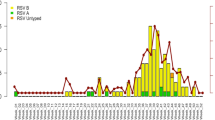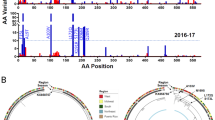Abstract
Respiratory syncytial virus (RSV) causes respiratory tract infection, particularly acute lower respiratory tract infection (ALRTI), in early childhood. The RSV fusion protein (F protein) is an important surface protein, and it is the target of both cytotoxic T lymphocytes (CTL) and neutralizing antibodies; thus, it may be useful as a candidate for vaccine research. This study investigated the genetic diversity of the RSV F protein. To this end, a total of 1800 nasopharyngeal aspirates from hospitalized children with ALRTI were collected for virus isolation between June 2009 and March 2012. There were 333 RSV-positive cases (277 cases of RSV A, 55 of RSV B, and 1 with both RSV A and RSV B), accounting for 18.5 % of the total cases. Next, 130 clinical strains (107 of RSV A, 23 of RSV B) were selected for F gene sequencing. Phylogenetic analysis revealed that the F gene sequence is highly conserved, with significant amino acid changes at residues 16, 25, 45, 102, 122, 124, 209, and 447. Mutations in human histocompatibility leukocyte antigen (HLA)-restricted CTL epitopes were also observed. Variations in RSV A F protein at the palivizumab binding site 276 (N→S) increased between 2009 and 2012 and became predominant. Western blot analysis and microneutralization data showed a substitution at residue 276 (N→S) in RSV A that did not cause resistance to palivizumab. In conclusion, the RSV F gene is geographically and temporally conserved, but limited genetic variations were still observed. These data could be helpful for the development of vaccines against RSV infection.




Similar content being viewed by others
References
Adams O, Bonzel L, Kovacevic A, Mayatepek E, Hoehn T, Vogel M (2010) Palivizumab-resistant human respiratory syncytial virus infection in infancy. Clin Infect Dis 51:185–188
Agenbach E, Tiemessen CT, Venter M (2005) Amino acid variation within the fusion protein of respiratory syncytial virus subtype A and B strains during annual epidemics in South Africa. Virus Genes 30:267–278
Andabaka T, Nickerson JW, Rojas-Reyes MX, Rueda JD, Bacic Vrca V, Barsic B (2013) Monoclonal antibody for reducing the risk of respiratory syncytial virus infection in children. Cochrane Database Syst Rev 4:CD006602
Anderson LJ, Hierholzer JC, Bingham PG, Stone YO (1985) Microneutralization test for respiratory syncytial virus based on an enzyme immunoassay. J Clin Microbiol 22:1050–1052
Botosso VF, Zanotto PM, Ueda M, Arruda E, Gilio AE, Vieira SE, Stewien KE, Peret TC, Jamal LF, Pardini MI, Pinho JR, Massad E, Sant’anna OA, Holmes EC, Durigon EL (2009) Positive selection results in frequent reversible amino acid replacements in the G protein gene of human respiratory syncytial virus. PLoS Pathog 5:e1000254
Brandenburg AH, de Waal L, Timmerman HH, Hoogerhout P, de Swart RL, Osterhaus AD (2000) HLA class I-restricted cytotoxic T-cell epitopes of the respiratory syncytial virus fusion protein. J Virol 74:10240–10244
Costello HM, Ray WC, Chaiwatpongsakorn S, Peeples ME (2012) Targeting RSV with vaccines and small molecule drugs. Infect Disord Drug Targets 12:110–128
Day ND, Branigan PJ, Liu C, Gutshall LL, Luo J, Melero JA, Sarisky RT, Del Vecchio AM (2006) Contribution of cysteine residues in the extracellular domain of the F protein of human respiratory syncytial virus to its function. Virol J 3:34
De Baets S, Schepens B, Sedeyn K, Schotsaert M, Roose K, Bogaert P, Fiers W, Saelens X (2013) Recombinant influenza virus carrying the RSV F85-93 CTL epitope reduces respiratory syncytial virus replication in mice. J Virol
Gonzalez-Reyes L, Ruiz-Arguello MB, Garcia-Barreno B, Calder L, Lopez JA, Albar JP, Skehel JJ, Wiley DC, Melero JA (2001) Cleavage of the human respiratory syncytial virus fusion protein at two distinct sites is required for activation of membrane fusion. Proc Natl Acad Sci USA 98:9859–9864
Jones BG, Sealy RE, Rudraraju R, Traina-Dorge VL, Finneyfrock B, Cook A, Takimoto T, Portner A, Hurwitz JL (2012) Sendai virus-based RSV vaccine protects African green monkeys from RSV infection. Vaccine 30:959–968
Kanai Y, Boonsathorn N, Chittaganpitch M, Bai G, Li Y, Kase T, Takahashi K, Okuno Y, Jampangern W, Ikuta K, Sawanpanyalert P (2010) The impact of antigenic drift of influenza A virus on human herd immunity: sero-epidemiological study of H1N1 in healthy Thai population in 2009. Vaccine 28:5437–5444
Kim YK, Choi EH, Lee HJ (2007) Genetic variability of the fusion protein and circulation patterns of genotypes of the respiratory syncytial virus. J Med Virol 79:820–828
Liu C, Day ND, Branigan PJ, Gutshall LL, Sarisky RT, Del Vecchio AM (2007) Relationship between the loss of neutralizing antibody binding and fusion activity of the F protein of human respiratory syncytial virus. Virol J 4:71
Martinello RA, Chen MD, Weibel C, Kahn JS (2002) Correlation between respiratory syncytial virus genotype and severity of illness. J Infect Dis 186:839–842
McLellan JS, Chen M, Leung S, Graepel KW, Du X, Yang Y, Zhou T, Baxa U, Yasuda E, Beaumont T, Kumar A, Modjarrad K, Zheng Z, Zhao M, Xia N, Kwong PD, Graham BS (2013) Structure of RSV fusion glycoprotein trimer bound to a prefusion-specific neutralizing antibody. Science 340:1113–1117
Moore ML, Chi MH, Luongo C, Lukacs NW, Polosukhin VV, Huckabee MM, Newcomb DC, Buchholz UJ, Crowe JE Jr, Goleniewska K, Williams JV, Collins PL, Peebles RS Jr (2009) A chimeric A2 strain of respiratory syncytial virus (RSV) with the fusion protein of RSV strain line 19 exhibits enhanced viral load, mucus, and airway dysfunction. J Virol 83:4185–4194
Nair H, Nokes DJ, Gessner BD, Dherani M, Madhi SA, Singleton RJ, O’Brien KL, Roca A, Wright PF, Bruce N, Chandran A, Theodoratou E, Sutanto A, Sedyaningsih ER, Ngama M, Munywoki PK, Kartasasmita C, Simoes EA, Rudan I, Weber MW, Campbell H (2010) Global burden of acute lower respiratory infections due to respiratory syncytial virus in young children: a systematic review and meta-analysis. Lancet 375:1545–1555
Ou SY, Lin GY, Wu Y, Lu XD, Lin CX, Zhou RB (2009) Viral pathogens of acute lower respiratory tract infection in hospitalized children from East Guangdong of China. Zhongguo Dang Dai Er Ke Za Zhi 11:203–206
Papadopoulos NG, Gourgiotis D, Javadyan A, Bossios A, Kallergi K, Psarras S, Tsolia MN, Kafetzis D (2004) Does respiratory syncytial virus subtype influences the severity of acute bronchiolitis in hospitalized infants? Respir Med 98:879–882
Papenburg J, Carbonneau J, Hamelin M-È, Isabel S, Bouhy X, Ohoumanne N, Déry P, Paes BA, Corbeil J, Bergeron MG, De Serres G, Boivin G (2012) Molecular evolution of respiratory syncytial virus fusion gene, Canada, 2006–2010. Emerg Infect Dis 18:120–124
Perkins SM, Webb DL, Torrance SA, El Saleeby C, Harrison LM, Aitken JA, Patel A, DeVincenzo JP (2005) Comparison of a real-time reverse transcriptase PCR assay and a culture technique for quantitative assessment of viral load in children naturally infected with respiratory syncytial virus. J Clin Microbiol 43:2356–2362
Plows DJ, Pringle CR (1995) Variation in the fusion glycoprotein gene of human respiratory syncytial virus subgroup A. Virus Genes 11:37–45
Rawling J, Garcia-Barreno B, Melero JA (2008) Insertion of the two cleavage sites of the respiratory syncytial virus fusion protein in Sendai virus fusion protein leads to enhanced cell-cell fusion and a decreased dependency on the HN attachment protein for activity. J Virol 82:5986–5998
Ren XW, Ju LW, Yang JX, Lv XH, Jiang LF, Zhao NQ, Jiang QW (2011) Antigenic and genetic variation in the hemagglutinins of H1N1 and H3N2 human influenza a viruses in the Shanghai area from 2005 to 2008. J Med Virol 83:1113–1120
Resch B, Michel-Behnke I (2013) Respiratory syncytial virus infections in infants and children with congenital heart disease: update on the evidence of prevention with palivizumab. Curr Opin Cardiol 28:85–91
Rock MT, Crowe JE Jr (2003) Identification of a novel human leucocyte antigen-A*01-restricted cytotoxic T-lymphocyte epitope in the respiratory syncytial virus fusion protein. Immunology 108:474–480
Schlender J, Zimmer G, Herrler G, Conzelmann KK (2003) Respiratory syncytial virus (RSV) fusion protein subunit F2, not attachment protein G, determines the specificity of RSV infection. J Virol 77:4609–4616
Shao HY, Lin YW, Yu SL, Lin HY, Chitra E, Chang YC, Sia C, Chong P, Hsu MT, Wei OL, Chow YH (2011) Immunoprotectivity of HLA-A2 CTL peptides derived from respiratory syncytial virus fusion protein in HLA-A2 transgenic mouse. PLoS One 6:e25500
Smith EC, Popa A, Chang A, Masante C, Dutch RE (2009) Viral entry mechanisms: the increasing diversity of paramyxovirus entry. FEBS J 276:7217–7227
Sun Z, Pan Y, Jiang S, Lu L (2013) Respiratory syncytial virus entry inhibitors targeting the F protein. Viruses 5:211–225
Tripp R, Jang J-E, Lee J-B, Kim K-H, Park SM, Shim B-S, Cheon IS, Song MK, Chang J (2011) Evaluation of protective efficacy of respiratory syncytial virus vaccine against A and B subgroup human isolates in Korea. PLoS One 6:e23797
Xie ZD, Xiao Y, Liu CY, Hu YH, Yao Y, Yang Y, Qian SY, Geng R, Wang JW, Shen KL (2011) Three years surveillance of viral etiology of acute lower respiratory tract infection in children from 2007 to 2010. Zhonghua Er Ke Za Zhi 49:745–749
Zhang Zy, Du Ln, Chen X, Zhao Y, Liu Em, Yang Xq, Zhao Xd (2010) Genetic variability of respiratory syncytial viruses (RSV) prevalent in Southwestern China from 2006 to 2009: emergence of subgroup B and A RSV as dominant strains. J Clin Microbiol 48:1201–1207
Zhao X (2004) Respiratory syncytial virus escape mutant derived in vitro resists palivizumab prophylaxis in cotton rats. Virology 318:608–612
Zhao X, Sullender WM (2005) In vivo selection of respiratory syncytial viruses resistant to palivizumab. J Virol 79:3962–3968
Zhu Q, McAuliffe JM, Patel NK, Palmer-Hill FJ, Yang CF, Liang B, Su L, Zhu W, Wachter L, Wilson S, MacGill RS, Krishnan S, McCarthy MP, Losonsky GA, Suzich JA (2011) Analysis of respiratory syncytial virus preclinical and clinical variants resistant to neutralization by monoclonal antibodies palivizumab and/or motavizumab. J Infect Dis 203:674–682
Zhu Q, Patel NK, McAuliffe JM, Zhu W, Wachter L, McCarthy MP, Suzich JA (2012) Natural polymorphisms and resistance-associated mutations in the fusion protein of respiratory syncytial virus (RSV): effects on RSV susceptibility to palivizumab. J Infect Dis 205:635–638
Zimmer G, Budz L, Herrler G (2001) Proteolytic activation of respiratory syncytial virus fusion protein. Cleavage at two furin consensus sequences. J Biol Chem 276:31642–31650
Acknowledgements
We thank the staff at Department of Respiratory Medicine for assistance in collection of clinical specimens. We thank all the patients or individuals for their enrollment and participation for this study. This work was supported in part by a China Special Grant of the Prevention and Control of Infection Diseases [2009ZX10004-204] and a grant from the Second Colleges and Universities Excellent Talents Program in Chongqing (2011.1-2012.12).
Conflict of interest
The authors declared that there are no conflicts of interest.
Author information
Authors and Affiliations
Corresponding author
Additional information
The GenBank accession numbers of the nucleotide sequences of complete RSV fusion protein genes obtained in this study are JX482018-JX482038 and JX682715-JX682823.
Rights and permissions
About this article
Cite this article
Xia, Q., Zhou, L., Peng, C. et al. Detection of respiratory syncytial virus fusion protein variants between 2009 and 2012 in China. Arch Virol 159, 1089–1098 (2014). https://doi.org/10.1007/s00705-013-1870-9
Received:
Accepted:
Published:
Issue Date:
DOI: https://doi.org/10.1007/s00705-013-1870-9




